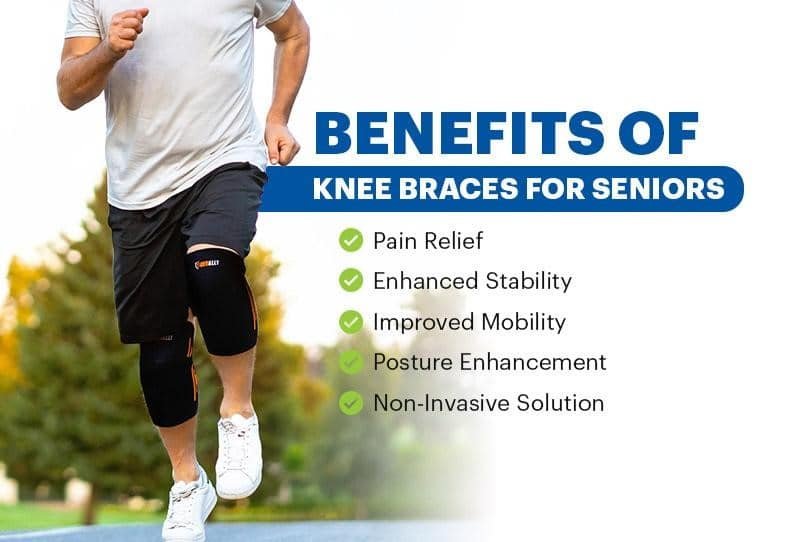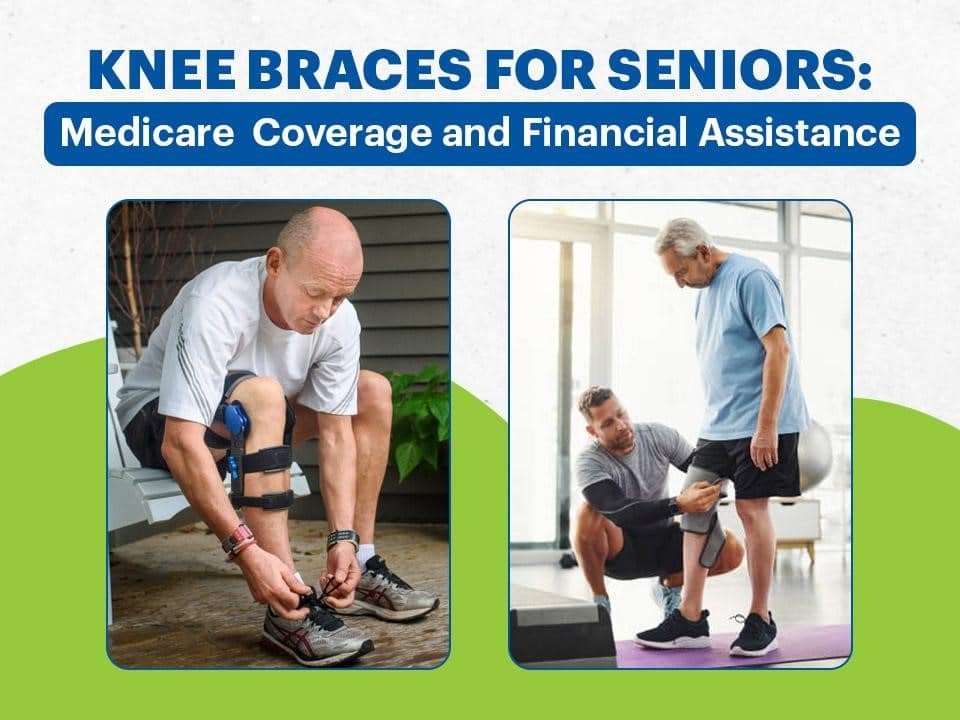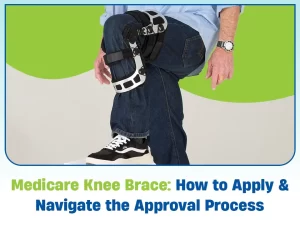As we age, maintaining mobility and independence becomes increasingly important. For many seniors, knee pain and related mobility issues can be significant barriers to enjoying an active and fulfilling life. Fortunately, knee braces can offer valuable support, and for those eligible, Medicare coverage and financial assistance can make these aids more accessible. In this guide, we will explore the world of knee braces for seniors, their benefits, how Medicare coverage works, and financial assistance options to ensure seniors can continue to lead active lives.
Understanding Knee Pain in Seniors
Knee pain is a prevalent and often distressing issue for many seniors. It can stem from various factors, including conditions like arthritis, osteoarthritis, injuries, or daily life’s natural wear and tear. Regardless of the cause, knee pain can significantly impact an older adult’s life, affecting their mobility and overall quality of life. In such cases, knee braces emerge as a non-invasive and effective solution designed to address these challenges, offering pain relief, stability, and improved mobility to seniors.
The Impact of Knee Pain
Knee pain can have far-reaching effects on a senior’s daily activities and well-being. It can lead to:
- Reduced Mobility: Persistent knee pain often limits a senior’s ability to move freely, challenging basic tasks like walking or climbing stairs.
- Decreased Quality of Life: The discomfort and inconvenience caused by knee pain can decrease the overall quality of life, affecting one’s enjoyment of daily activities and hobbies.
- Independence Challenges: For seniors who value their independence, knee pain can be particularly disheartening, as it may necessitate assistance with tasks they once managed independently.
- Risk of Falls: Pain in the knees can lead to instability, increasing the risk of falls and related injuries, which can be especially concerning for older adults.
The Role of Knee Braces
Knee braces are a valuable tool for seniors dealing with knee pain. These devices are designed to provide the necessary support, stability, and pain relief, allowing older individuals to regain their mobility and independence. Whether the knee pain is due to arthritis, injury, or other factors, knee braces offer a non-invasive solution to help seniors lead a more comfortable and active life.
In the following sections, we will explore the benefits of knee braces for seniors, Medicare coverage eligibility criteria, and financial assistance options to make these essential devices more accessible to older adults seeking relief from knee pain.
Benefits of Knee Braces for Seniors
Before delving into the details of Medicare coverage and financial assistance, it’s essential to understand the advantages of knee braces for seniors. These supportive devices offer several benefits that can significantly improve the quality of life for older individuals:

- Pain Relief: Knee braces provide targeted compression and support, effectively reducing pain and discomfort associated with various knee conditions. Seniors can enjoy a higher level of comfort in their daily lives.
- Enhanced Stability: These braces offer stability to the knee joint, diminishing the risk of falls or injuries caused by instability. Seniors can move with confidence and reduce the fear of accidents.
- Improved Mobility: With proper knee brace support, seniors can experience enhanced mobility and flexibility. This improved mobility makes it easier to perform daily activities, stay active, and enjoy a more independent lifestyle.
- Posture Enhancement: Knee braces promote and maintain proper posture, alleviating knee strain. This not only aids in pain management but also helps prevent further damage to the knees.
- Non-Invasive Solution: Knee braces are a non-invasive alternative to surgery for effectively managing knee pain. Seniors can avoid the risks and recovery associated with surgical procedures while still finding relief and support.
Understanding these benefits highlights knee braces’ significance in enhancing seniors’ daily lives, allowing them to age gracefully and comfortably.
Eligibility for Medicare Coverage
If you’re a senior looking to leverage Medicare coverage for knee braces, it’s crucial to understand the specific eligibility criteria that apply. Typically, the following requirements must be met to access this coverage:
- Medicare Beneficiary: To be eligible for Medicare coverage for knee braces, seniors must be enrolled in Medicare Part B. This aspect of Medicare covers durable medical equipment, including knee braces, ensuring access to necessary medical aids.
- Medical Necessity: While being a Medicare beneficiary is a fundamental requirement, it’s equally important that a healthcare provider deems the knee brace medically necessary. A qualified healthcare professional must prescribe the knee brace, providing explicit documentation that outlines the medical need for its use.
Meeting these eligibility criteria is essential to ensure seniors can access Medicare coverage for knee braces, which can significantly aid their comfort and mobility. It’s advisable to consult with a healthcare provider to determine the suitability of a knee brace and obtain the necessary prescription. This ensures a smoother process when seeking coverage through Medicare.
How Medicare Coverage Works
Understanding how Medicare coverage works for knee braces is essential for seniors seeking relief from knee pain. Medicare Part B is typically the component of Medicare responsible for covering durable medical equipment (DME), which includes knee braces. However, it’s crucial to recognize that the coverage specifics can vary based on several factors, such as the type of brace, the supplier’s Medicare enrollment status, and whether the brace is deemed medically necessary.
Medicare Part B and DME Coverage
Medicare Part B is a federal health insurance program that covers various medical services and necessary supplies. Durable medical equipment (DME) is one category of items that falls under Part B coverage. DME includes a wide range of devices and equipment designed for medical purposes, and knee braces are considered one of these valuable items.
Factors Affecting Coverage
While knee braces are generally eligible for Medicare coverage under Part B, certain factors can influence the specifics of that coverage:
- Type of Knee Brace: The type and design of the knee brace prescribed by your healthcare provider may impact coverage. It’s essential to ensure that the prescribed brace meets Medicare’s criteria for coverage.
- Supplier Enrollment: Medicare has a list of approved suppliers for DME, including knee braces. Choosing a supplier enrolled in Medicare is crucial to receiving coverage. Using an approved supplier helps ensure that you receive high-quality, Medicare-covered knee braces.
- Medical Necessity: Medicare requires medical equipment, including knee braces, to be deemed medically necessary for coverage. Your healthcare provider must prescribe the knee brace and specify its medical necessity based on your condition.
- Coverage Guidelines: Medicare has specific guidelines and rules regarding coverage for knee braces. Understanding these guidelines and working closely with your healthcare provider to ensure compliance is essential.
Read More: Knee Braces Covered by Medicare: Eligibility and Benefits
Financial Assistance Options for Seniors
For seniors concerned about the cost of knee braces, various financial assistance programs and resources are available to help alleviate the financial burden:

- Medicare Supplement Plans: Some Medicare Supplement (Medigap) plans may cover additional costs associated with knee braces, reducing out-of-pocket expenses.
- Medicaid: Eligible low-income seniors may receive assistance through Medicaid for medical equipment, including knee braces, ensuring access to necessary support without added financial stress.
- State Assistance Programs: Some states offer additional financial aid programs to help seniors cover medical equipment costs. These state-specific initiatives can provide valuable financial relief.
- Non-Profit Organizations: Certain nonprofit organizations focus on supporting seniors needing medical devices. They may offer grants or assistance programs tailored to the unique needs of older individuals.
- Veterans Benefits: Veterans can explore coverage for knee braces through the Department of Veterans Affairs (VA). This avenue can provide comprehensive support for veterans seeking relief and mobility assistance.
By exploring these financial assistance options, seniors can make informed decisions about their knee brace needs while maintaining their financial well-being.
Tips for Choosing the Right Knee Brace
Selecting the appropriate knee brace is crucial to ensure optimal support and comfort for seniors. Here are some valuable tips to consider:
- Consult with a Healthcare Provider: Discuss your knee condition with a healthcare provider or orthopedic specialist. They can provide valuable guidance on the type of knee brace that suits your needs.
- Ensure Comfort and Fit: Comfort is paramount. Ensure the knee brace fits correctly and provides optimal support without causing discomfort or skin irritation.
- Look for Adjustability: Opt for knee braces with adjustable features such as straps or closures. These allow you to customize the level of support based on your needs.
- Material and Breathability: Consider the brace’s material. Choosing a knee brace made of breathable materials can prevent excessive sweating and skin irritation, enhancing overall comfort.
- Activity Level and Lifestyle: When selecting a knee brace, consider your activity level and lifestyle. Some braces are suitable for everyday wear, while others are designed for specific activities or recovery periods.
Putting on and Using Your Knee Brace Correctly
Proper usage of a knee brace is essential to achieve the desired comfort and effectiveness. Follow these steps for the correct application:
- Prepare the Brace: Ensure your knee brace is clean and in good condition before wearing it.
- Find a Comfortable Spot: Sit in a comfortable chair or on the edge of your bed to make the process easier.
- Position Your Leg: Slightly extend your leg and carefully place the knee brace over your knee joint.
- Secure Straps or Closures: Depending on the type of knee brace, fasten the straps or closures from the bottom and work your way up. Ensure a snug fit without overtightening to avoid discomfort.
- Check for Comfort: Confirm that the brace feels comfortable and does not cause any irritation or pressure points.
- Mobility Test: Stand up and test your mobility with the knee brace on. Make sure it provides the necessary support without restricting your movements excessively.
Caring for Your Knee Brace
Proper maintenance and care are crucial to maximize the longevity and effectiveness of your knee brace. Here are some essential tips:
- Regular Cleaning: Clean your knee brace regularly to prevent dirt, sweat, and bacteria buildup. Follow the manufacturer’s cleaning instructions for the best results.
- Frequent Inspection: Regularly inspect the brace for any signs of wear and tear. Ensure that all components, including straps and closures, are functioning correctly.
- Skin Protection: Consider wearing a moisture-wicking undershirt beneath the brace to prevent skin irritation.
- Follow Care Instructions: Always adhere to the care instructions the supplier or manufacturer provides. Proper care and maintenance can extend the life of your knee brace and ensure its continued effectiveness in providing support and relief.
Conclusion
In conclusion, knee braces can significantly enhance the lives of seniors by providing pain relief, stability, and improved mobility. Understanding Medicare coverage, eligibility criteria, and financial assistance options is essential for seniors seeking comfort and support. By exploring these avenues, seniors can continue to enjoy active and fulfilling lives while effectively managing knee pain and related issues.







